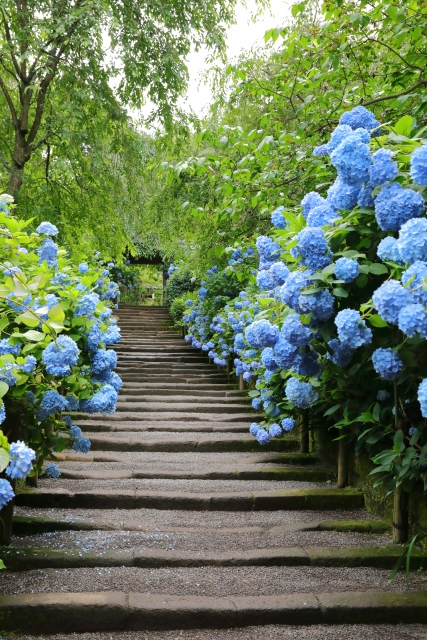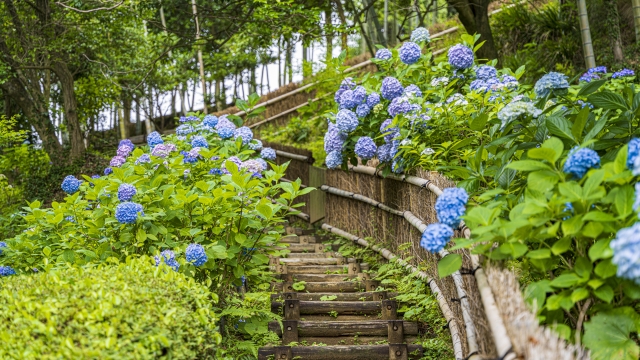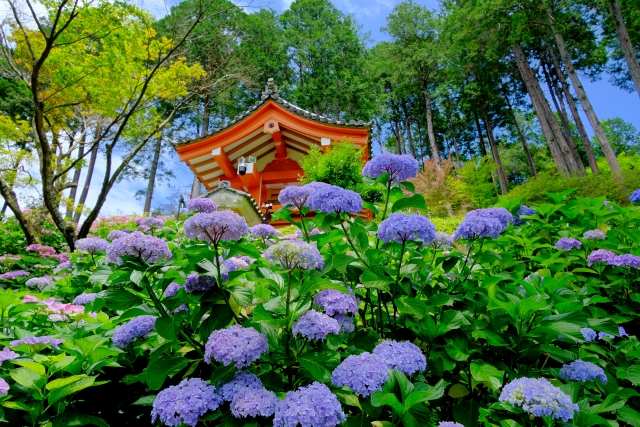From late May to early July, thousands of hydrangeas (known as “ajisai: あじさい、紫陽花” in Japanese) paint temples and gardens across Japan in stunning shades of blue, purple, and pink.
This guide will help you discover the best spots and times to witness this magical flower season that coincides with Japan’s rainy season.
When to See Hydrangeas in Japan
The hydrangea season in Japan typically aligns with the rainy season (tsuyu), creating a mystical atmosphere as these beautiful flowers thrive in the humid climate.
While exact blooming times vary by region and yearly weather conditions, you can generally enjoy these magnificent blooms for about 3-4 weeks at each location.
Best Time
Here’s a general timeline for optimal hydrangea viewing across Japan:
- Late May to early June: Southern regions (Kyushu, Shikoku)
- Early to late June: Central Japan (Tokyo, Kanagawa, Kansai)
- Late June to mid-July: Northern regions (Tohoku, Hokkaido)
For the best viewing experience, try to visit on a cloudy or slightly rainy day. The moisture enhances the colors of the flowers, and the soft light creates perfect conditions for photography.
Many temples and gardens are less crowded on rainy days, offering a more peaceful viewing experience.
Regional Bloom Differences
The blooming schedule varies significantly across Japan due to different climate conditions and elevation levels.
Here’s a detailed breakdown of peak viewing times by region:
| Region | Peak Bloom Period | Notable Characteristics |
|---|---|---|
| Tokyo/Kanagawa | June 5 – June 25 | Urban gardens and historic temples |
| Kansai | June 1 – June 20 | Mountain temples and traditional gardens |
| Hokkaido | Late June – Mid July | Larger blooms due to cool climate |
Climate change may slightly affect these blooming periods, so it’s recommended to check local flower forecasts closer to your planned visit date.
Top Hydrangea Viewing Spots
Japan boasts numerous locations famous for their hydrangea displays, ranging from centuries-old temples to meticulously maintained gardens.
Famous Ajisai Temples

These historic temples are renowned for their spectacular hydrangea displays, combining spiritual atmosphere with natural beauty.
- Meigetsu-in Temple (Kamakura) Known as the “Hydrangea Temple,” featuring over 2,500 hydrangea plants and a famous circular window framing the garden.
- Hase-dera Temple (Kamakura) Home to over 40 varieties of hydrangeas on its hillside garden, offering panoramic views of Sagami Bay.
- Mimurotoji Temple (Uji, Kyoto) Called the “Temple of Flowers,” featuring a stunning hydrangea garden with over 10,000 plants.
Famous Ajisai Gardens
While temples offer a traditional setting, Japan’s dedicated hydrangea gardens provide meticulously designed landscapes that showcase these beautiful flowers in their full glory.
Here are some must-visit hydrangea gardens:
- Hakusan Shrine (Tokyo) A hidden oasis in the city with over 3,000 hydrangea plants representing 50 varieties.
- Shimizu Park (Chiba) Features over 15,000 hydrangea plants and an annual hydrangea festival.
- Fuji Five Lakes (Yamanashi) Offers stunning views of hydrangeas with Mount Fuji as a backdrop.
Hidden Gems
Beyond the famous spots, Japan harbors numerous lesser-known locations that offer equally impressive hydrangea viewing opportunities, often with fewer crowds and a more intimate atmosphere.
Consider these off-the-beaten-path destinations:
- Hattori Farm (Shiga Prefecture) A family-run farm featuring over 5,000 naturally grown hydrangeas in a mountain setting.
- Taihei-ji Temple (Kanagawa) A peaceful temple with a beautiful hydrangea path leading to a historic cemetery.
- Yanagida Rose Park (Gifu) Known primarily for roses but features a spectacular hydrangea garden that few tourists visit.
Types of Japanese Hydrangeas
Japanese gardens cultivate several distinct varieties of hydrangeas, each with its own unique characteristics and beauty.
Understanding these differences can enhance your appreciation during your visit.
Common Varieties and Colors
Japanese gardens feature several popular hydrangea varieties, each contributing to the diverse color palette you’ll encounter.
The soil pH levels can affect the color of many varieties, creating fascinating variations even within the same garden.
| Variety | Characteristics | Common Colors |
|---|---|---|
| Gaku Ajisai | Lacecap type with flat flowers | Blue, Pink, White |
| Hime Ajisai | Small, delicate flowers | Purple, Blue |
| Annabelle | Large, round flower heads | Pure White |
Mountain Hydrangeas vs Temple Hydrangeas
Japanese hydrangeas can be broadly categorized into two main growing environments, each producing distinct characteristics in the flowers.
Mountain hydrangeas tend to be more resilient and compact, with deeper colors due to the cooler climate and specific soil conditions.
Temple hydrangeas, cultivated in more controlled environments, often display more uniform colors and larger blooms thanks to centuries of careful cultivation.
Planning Your Hydrangea Visit

A successful hydrangea viewing experience requires some preparation, especially considering the rainy season timing.
Here’s what you need to know to make the most of your visit.
What to Wear?
Given that hydrangea season coincides with Japan’s rainy season, appropriate attire is essential for a comfortable viewing experience:
- Rain gear: Bring a compact umbrella and water-resistant footwear
- Comfortable clothing: Light, quick-drying materials are recommended
- Walking shoes: Many gardens feature hillside paths and stairs
Transportation?
Many popular hydrangea spots are accessible by public transportation, though some hidden gems might require additional planning.
Consider purchasing a Japan Rail Pass if you plan to visit multiple regions.
Most temple gardens are accessible via local trains and buses, with increased services during peak blooming seasons.
Admission Fees and Opening Hours
While some public parks offer free hydrangea viewing, most temples and private gardens charge admission fees.
- Temple gardens: ¥300-900 per adult
- Public parks: Usually free
- Special gardens: ¥500-1,500 per adult
Many locations offer extended hours during peak season, with some temples and gardens featuring special illumination events in the evening.
The hydrangea season in Japan offers a unique opportunity to experience the country’s natural beauty and cultural heritage.



comment